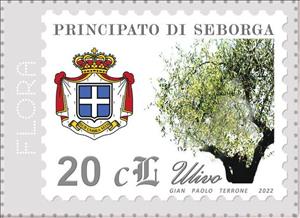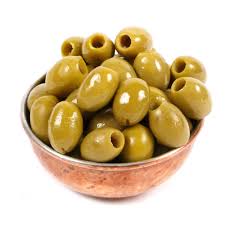Stamp: Olive tree (Cinderellas 2022)
Olive tree (Cinderellas 2022)
20 August (Cinderellas ) within release Italy : Principality of Seborga goes into circulation Stamp Olive tree face value 20 Seborgan cent
| Stamp Olive tree in catalogues | |
|---|---|
| Colnect codes: | Col: IT-SB 2022-03/9 |
Stamp is square format.
Stamp from mini sheetAlso in the issue Italy : Principality of Seborga:
- Stamp - Bee face value 20;
- Stamp - Black tomato face value 20;
- Stamp - Boar face value 20;
- Stamp - Broom face value 20;
- Stamp - Church of San Bernardo face value 20;
- Stamp - Church of San Martino face value 20;
- Stamp - Coat of arms of the Principality face value 20;
- Stamp - Flag of the Principality face value 20;
- Mini Sheet - Flora, fauna and food S/S face value 9*20;
- Stamp - Guards face value 20;
- Stamp - Knights Templar face value 20;
- Stamp - Knights Templar face value 20;
- Stamp - Luigino coin, 1669 face value 20;
- Stamp - Luigino coin, 2021 face value 20;
- Stamp - Mimosa face value 20;
- Stamp - Nina Menegatto (1978-), Princess of Seborga face value 20;
- Stamp - Nina Menegatto (1978-), Princess of Seborga face value 20;
- Stamp - Olive tree face value 20;
- Stamp - Pastel drawing of Piazza della Libertà face value 20;
- Stamp - Pastel drawing of Piazza della Libertà face value 20;
- Stamp - Pesto face value 20;
- Stamp - Taggiasco oil face value 20;
- Stamp - View of Seborga face value 20;
- Stamp - View of Seborga, Fiat 500 and Princess Nina face value 20;
- Mini Sheet - Views from the Principality of Seborga S/S face value 6*20;
- Mini Sheet - Views from the Principality of Seborga S/S face value 9*20;
- Stamp - Wild rabbit face value 20;
|
Data entry completed
50%
|
|
|---|---|
| Stamp Olive tree in digits | |
| Country: | Cinderellas |
| Date: | 2022-08-20 |
| Emission: | Cinderella |
| Format: | Stamp |
| Face Value: | 20 Seborgan cent |
Stamp Olive tree it reflects the thematic directions:
A coat of arms is an heraldic visual design on an escutcheon (i.e. shield), surcoat, or tabard. The coat of arms on an escutcheon forms the central element of the full heraldic achievement which in its whole consists of shield, supporters, crest, and motto. A coat of arms is traditionally unique to an individual person, family (except in the United Kingdom), state, organisation or corporation.
In British heraldry, a coronet is any crown whose bearer is less than sovereign or royal in rank, irrespective of the crown's appearance. In other languages, this distinction is not made, and usually the same word for crown is used irrespective of rank (German: Krone, Dutch: Kroon, Swedish: Krona, French: Couronne, etc.) In this use, the English coronet is a purely technical term for all heraldic images of crowns not used by a sovereign, and implies nothing about the actual shape of the crown depicted. A Coronet is another type of crown, but is reserved for the lower ranks of nobility like Marquesses and Marchionesses, Earls and Countesses, Barons and Baronesses, and some Lords and Ladies. The specific design and attributes of the crown or coronet signifies the hierarchy and ranking of its owner.
The olive, botanical name Olea europaea, meaning 'European olive', is a species of small tree or shrub in the family Oleaceae, found traditionally in the Mediterranean Basin, with wild subspecies found further afield in Africa and western Asia. When in shrub form, it is known as Olea europaea 'Montra', dwarf olive, or little olive. The species is cultivated in all the countries of the Mediterranean, as well as in Australia, New Zealand, North and South America and South Africa. It is the type species for its genus, Olea. The tree and its fruit give their name to the Oleaceae plant family, which also includes species such as lilac, jasmine, forsythia, and the true ash tree.
Flora is the plant life occurring in a particular region or time, generally the naturally occurring or indigenous—native plant life. The corresponding term for animal life is fauna. Flora, fauna and other forms of life such as fungi are collectively referred to as biota. Sometimes bacteria and fungi are also referred to as flora, as in the terms gut flora or skin flora.
In botany, a tree is a perennial plant with an elongated stem, or trunk, supporting branches and leaves in most species. In some usages, the definition of a tree may be narrower, including only woody plants with secondary growth, plants that are usable as lumber or plants above a specified height. Trees are not a taxonomic group but include a variety of plant species that have independently evolved a woody trunk and branches as a way to tower above other plants to compete for sunlight. In looser senses, the taller palms, the tree ferns, bananas and bamboos are also trees. Trees tend to be long-lived, some reaching several thousand years old. The tallest known tree, a coast redwood named Hyperion, stands 115.6 m (379 ft) high. Trees have been in existence for 370 million years. It is estimated that there are just over 3 trillion mature trees in the world. A tree typically has many secondary branches supported clear of the ground by the trunk. This trunk typically contains woody tissue for strength, and vascular tissue to carry materials from one part of the tree to another. For most trees it is surrounded by a layer of bark which serves as a protective barrier. Below the ground, the roots branch and spread out widely; they serve to anchor the tree and extract moisture and nutrients from the soil. Above ground, the branches divide into smaller branches and shoots. The shoots typically bear leaves, which capture light energy and convert it into sugars by photosynthesis, providing the food for the tree's growth and development. Flowers and fruit may also be present, but some trees, such as conifers, instead have pollen cones and seed cones; others, such as tree ferns, produce spores instead. Trees play a significant role in reducing erosion and moderating the climate. They remove carbon dioxide from the atmosphere and store large quantities of carbon in their tissues. Trees and forests provide a habitat for many species of animals and plants. Tropical rainforests are one of the most biodiverse habitats in the world. Trees provide shade and shelter, timber for construction, fuel for cooking and heating, and fruit for food as well as having many other uses. In parts of the world, forests are shrinking as trees are cleared to increase the amount of land available for agriculture. Because of their longevity and usefulness, trees have always been revered, with sacred groves in various cultures, and they play a role in many of the world's mythologies.





